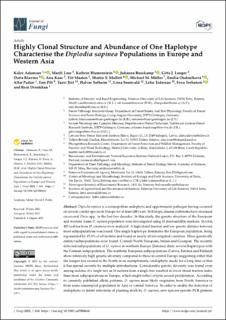Highly Clonal Structure and Abundance of One Haplotype Characterise the Diplodia sapinea Populations in Europe and Western Asia
| dc.contributor.author | Adamson, Kalev | |
| dc.contributor.author | Laas, Marili | |
| dc.contributor.author | Blumenstein, Kathrin | |
| dc.contributor.author | Busskamp, Johanna | |
| dc.contributor.author | Langer, Gitta J. | |
| dc.contributor.author | Klavina, Darta | |
| dc.contributor.author | Kaur, Anu | |
| dc.contributor.author | Maaten, Tiit | |
| dc.contributor.author | Mullett, Martin S. | |
| dc.contributor.author | Müller, Michael M. | |
| dc.contributor.author | Ondrušková, Emília | |
| dc.contributor.author | Padari, Allar | |
| dc.contributor.author | Pilt, Enn | |
| dc.contributor.author | Riit, Taavi | |
| dc.contributor.author | Solheim, Halvor | |
| dc.contributor.author | Soonvald, Liina | |
| dc.contributor.author | Tedersoo, Leho | |
| dc.contributor.author | Terhonen, Eeva | |
| dc.contributor.author | Drenkhan, Rein | |
| dc.date.accessioned | 2021-12-13T11:44:57Z | |
| dc.date.available | 2021-12-13T11:44:57Z | |
| dc.date.created | 2021-08-23T14:18:07Z | |
| dc.date.issued | 2021-08-04 | |
| dc.identifier.citation | Journal of fungi (JoF). 2021, 7 (8), 1-23. | en_US |
| dc.identifier.issn | 2309-608X | |
| dc.identifier.uri | https://hdl.handle.net/11250/2833974 | |
| dc.description.abstract | Diplodia sapinea is a cosmopolitan endophyte and opportunistic pathogen having occurred on several conifer species in Europe for at least 200 years. In Europe, disease outbreaks have increased on several Pinus spp. in the last few decades. In this study, the genetic structure of the European and western Asian D. sapinea population were investigated using 13 microsatellite markers. In total, 425 isolates from 15 countries were analysed. A high clonal fraction and low genetic distance between most subpopulations was found. One single haplotype dominates the European population, being represented by 45.3% of all isolates and found in nearly all investigated countries. Three genetically distinct subpopulations were found: Central/North European, Italian and Georgian. The recently detected subpopulations of D. sapinea in northern Europe (Estonia) share several haplotypes with the German subpopulation. The northern European subpopulations (Latvia, Estonia and Finland) show relatively high genetic diversity compared to those in central Europe suggesting either that the fungus has existed in the North in an asymptomatic/endophytic mode for a long time or that it has spread recently by multiple introductions. Considerable genetic diversity was found even among isolates of a single tree as 16 isolates from a single tree resulted in lower clonal fraction index than most subpopulations in Europe, which might reflect cryptic sexual proliferation. According to currently published allelic patterns, D. sapinea most likely originates from North America or from some unsampled population in Asia or central America. In order to enable the detection of endophytic or latent infections of planting stock by D. sapinea, new species-specific PCR primers (DiSapi-F and Diplo-R) were designed. During the search for Diplodia isolates across the world for species specific primer development, we identified D. africana in California, USA, and in the Canary Islands, which are the first records of this species in North America and in Spain. | en_US |
| dc.language.iso | eng | en_US |
| dc.publisher | MDPI, Basel, Switzerland | en_US |
| dc.rights | Navngivelse 4.0 Internasjonal | * |
| dc.rights.uri | http://creativecommons.org/licenses/by/4.0/deed.no | * |
| dc.title | Highly Clonal Structure and Abundance of One Haplotype Characterise the Diplodia sapinea Populations in Europe and Western Asia | en_US |
| dc.type | Peer reviewed | en_US |
| dc.type | Journal article | en_US |
| dc.description.version | publishedVersion | en_US |
| dc.rights.holder | © 2021 by the authors | en_US |
| dc.source.pagenumber | 1-23 | en_US |
| dc.source.volume | 7 | en_US |
| dc.source.journal | Journal of fungi (JoF) | en_US |
| dc.source.issue | 8 | en_US |
| dc.identifier.doi | 10.3390/jof7080634 | |
| dc.identifier.cristin | 1928058 | |
| dc.source.articlenumber | 634 | en_US |
| cristin.ispublished | true | |
| cristin.fulltext | original | |
| cristin.qualitycode | 1 |
Files in this item
This item appears in the following Collection(s)
-
Divisjon for bioteknologi og plantehelse [525]
Publikasjoner knyttet til ansatte ved Divisjon for bioteknologi og plantehelse -
Publikasjoner fra CRIStin - NIBIO [4554]
-
Vitenskapelige artikler [1416]

